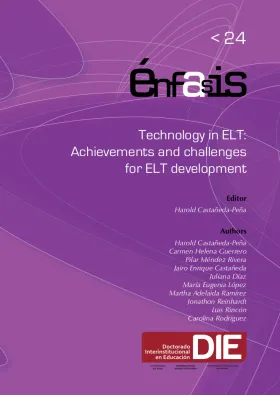
The Doctorado Interinstitucional en Educación (Interinstitutional Doctorate on Education), ELT Education Major, at Universidad Distrital Francisco José de Caldas was one of the stakeholders supporting the 51st ASOCOPI’s Annual Congress. Named after the title of this introduction the Congress was a vivid forum for English language teachers and experts interested in discussing how technology has been integrated into English language teaching (ELT) and learning. This book shows a selection of papers presented in the Congress that reflect achievements and challenges for English language teaching and learning development. There are three parts to this book, which constitute the three Rs of technology in ELT as a contribution of this Congress for the academic community: Rethinking, Researching and Re-experiencing.
The two chapters in Part I are based on reflections that operate as a response to the paradigm shifts within education where the use of information and communication technologies have transited from technical and instrumental curricular views to more praxis-based or critical ones. Reinhardt (this volume) presents a “literacies-informed approach to developing autonomy that balances agency and awareness” within a social media framework. In presenting a state of the art of research on social media in second language teaching and learning, Reinhardt establishes that social media technologies such as blogs, wikis, social networking sites, as well as SNECSs are the context where L2 learning could be facilitated. They should also be constrained if conditions for learners’ investment and autonomy are not sensitive to the “micro-politics” of social media use for educational purposes. In order to develop social media enhanced learner-autonomy it is challenging to bear in mind the interrelationship between agency and awareness. Méndez and Guerrero (this volume) critically examine potential contributions of virtual learning environments to the professional development and profiles of English language teachers. It is suggested that in such contexts of professional development, the teacher as an intellectual, the possibilities for actual teaching, the emergence of other voices and situated practices should be taken into account. Méndez and Guerrero also introduce virtual learning environment competences that have become part of language teachers’ profiles incorporating resistance practices. Such practices if appropriately understood could aid to more adequate and context sensitive programs for language teachers’ professional development.
The chapters in this book illustrate a central debate: “Technology in ELT: Achievements and challenges for ELT development”. Surrounding this debate, one could draw on the relationships of agency and awareness in social media incorporation to education and L2 literacy development. One could also draw on the idea of (re)configuring resistances to fixed language teacher profiles and professional development opportunities for in-service teacher working within virtual learning environments. The book also illustrates research on preservice English language teacher, which aids to fuel the debate whether one incorporates strategies for lesson planning, for pedagogical reflection or for planning language instruction. Finally, within this debate, workshops inspired in principles of flipped learning explore the usefulness of thinking language instruction, skills development and professional development differently. What next? This book is a contribution to the debate and hopefully will be used as basis for continuing debating the issues that would open doors for new Technology in ELT achievements and challenges.
Technology in ELT: Achievements and challenges for ELT development
The Doctorado Interinstitucional en Educación (Interinstitutional Doctorate on Education), ELT Education Major, at Universidad Distrital Francisco José de Caldas was one of the stakeholders supporting the 51st ASOCOPI’s Annual Congress.
Social media in the L2 classroom: Everyday agency, awareness, and autonomy
While traditional modern foreign language educational practice has traditionally relegated everyday language to beginning levels, upholding prestige varieties, academic writing, and rarified literary practices for more advanced study, modern standards and guidelines promote proficiencies in verna
English teachers’ profiles and technology-related professional development
This chapter discusses the possible contributions of virtual learning environments (VLEs) to the English teachers’ professional development and teachers’ profiles.
Support from Web 2.0 tools to improve lesson planning and classroom management in a pre-practicum experience
This study emerged from the need to guide student teachers better for their pre-practicum experience and it was focused on supporting student teachers lesson plan and classroom management skills through the use of some Web 2.0 tools in a pre-practicum experience.
Foreign Language Teachers’ Education: Challenges and Implications in Integrating Technologies of Information and Communication
The process of globalization and the rapid development of science and technology have brought up challenges to education systems at all levels.
KANKURUBA: The use of Second Life for English Language Teacher Education
In order to understand educational practice(s), it seems paramount to understand praxis within teacher education in the context of pre-service English language teachers.
Optimizing the writing component of your EFL class through writing workshops
Planning for writing in an English as a Foreign Language class is usually a difficult task given the time constraints faced in the classroom and the little preparation and expertise students have in terms of writing.
In-Class Flip in Teacher Education Through Loop-Input
The 51st ASOCOPI conference held in Bogota in October 2016 gathered professionals from all over Colombia and the world around the topic of technology in the ELT classroom.